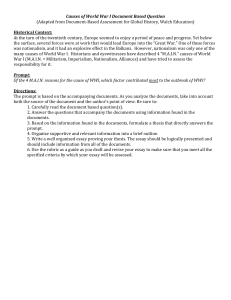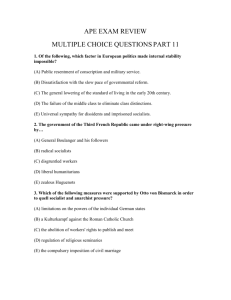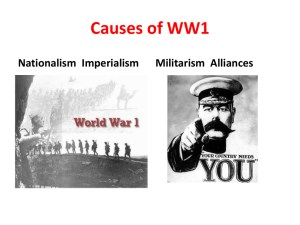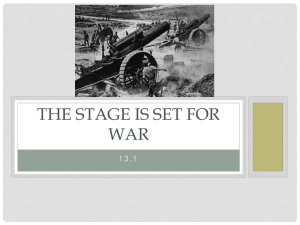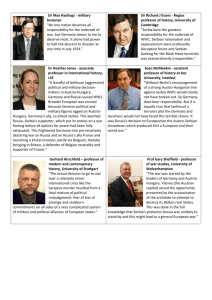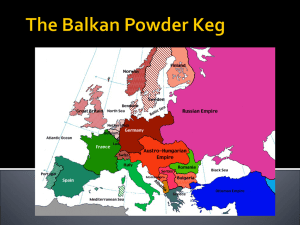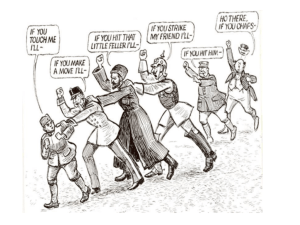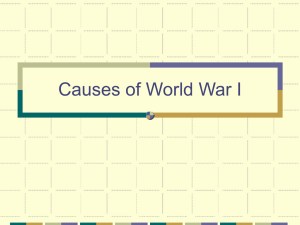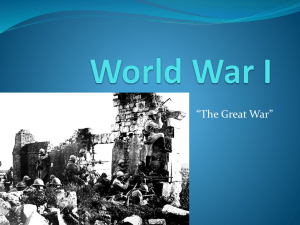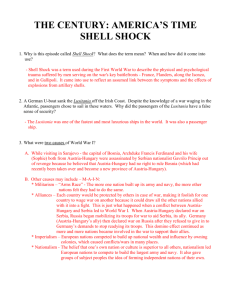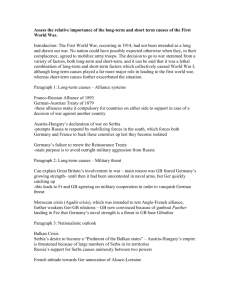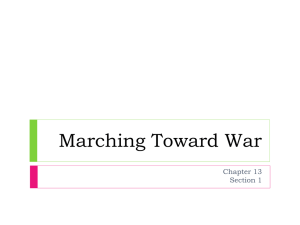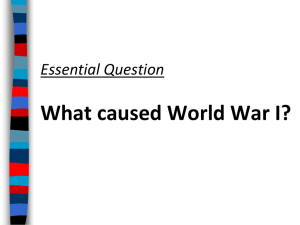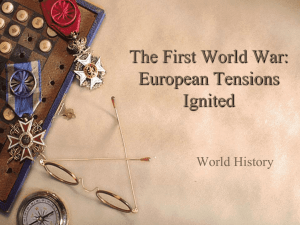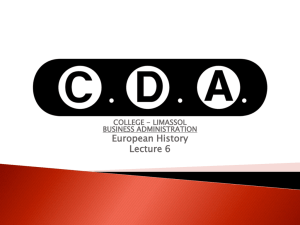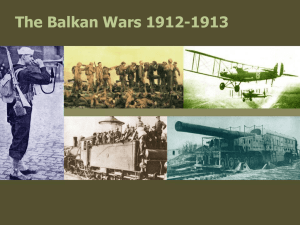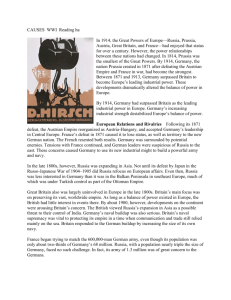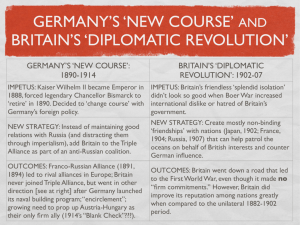Document Answer Key
advertisement
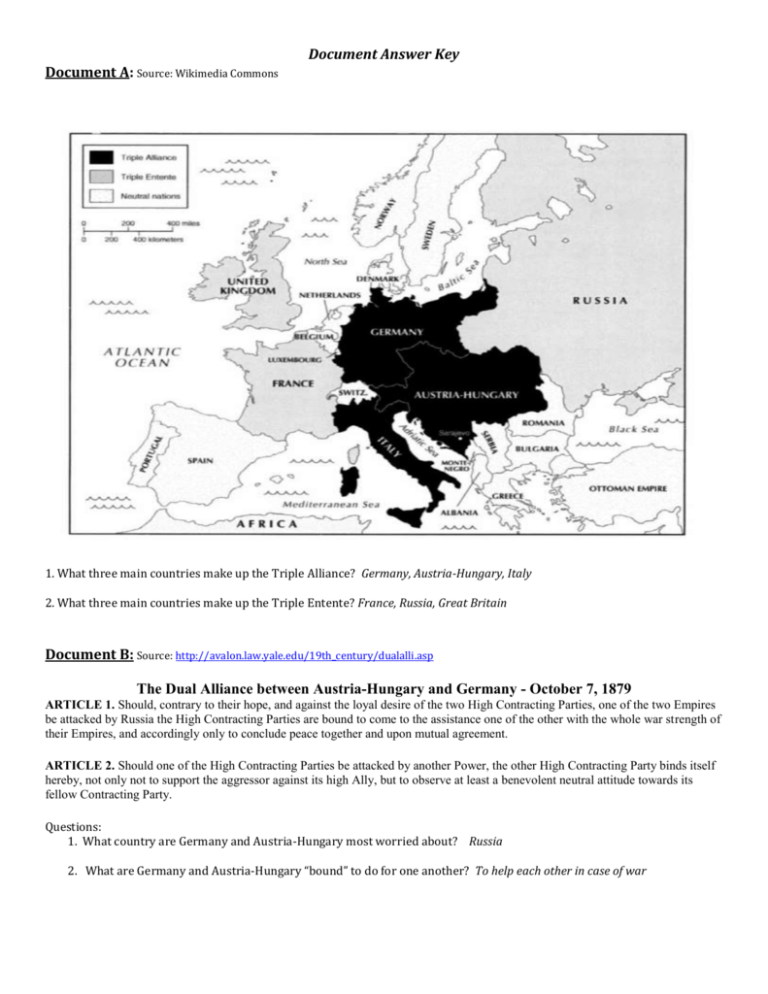
Document A: Source: Wikimedia Commons Document Answer Key 1. What three main countries make up the Triple Alliance? Germany, Austria-Hungary, Italy 2. What three main countries make up the Triple Entente? France, Russia, Great Britain Document B: Source: http://avalon.law.yale.edu/19th_century/dualalli.asp The Dual Alliance between Austria-Hungary and Germany - October 7, 1879 ARTICLE 1. Should, contrary to their hope, and against the loyal desire of the two High Contracting Parties, one of the two Empires be attacked by Russia the High Contracting Parties are bound to come to the assistance one of the other with the whole war strength of their Empires, and accordingly only to conclude peace together and upon mutual agreement. ARTICLE 2. Should one of the High Contracting Parties be attacked by another Power, the other High Contracting Party binds itself hereby, not only not to support the aggressor against its high Ally, but to observe at least a benevolent neutral attitude towards its fellow Contracting Party. Questions: 1. What country are Germany and Austria-Hungary most worried about? Russia 2. What are Germany and Austria-Hungary “bound” to do for one another? To help each other in case of war Document C: Source: http://www.authentichistory.com/1914-1920/1-overview/1-origins/index.html “By the 1890s, the great land armies of France, Germany, Austria-Hungary, and Russia had no equals on earth except one another. Nicholas warned that “the accelerating arms race”, which was producing larger armies, more powerful artillery, and bigger warships, was “transforming the armed peace into a crushing burden that weighs on all nations and, if prolonged, will lead to the very cataclysm it seeks to avert.” Unfortunately, participation in the international court was voluntary. The next year, in an attempt to compensate for its small empire, Germany enacted the Second Naval Law, intending to build a navy capable of challenging the British Royal Navy in combat. The British responded. By 1906, keeping ahead of the Germans in modern battleships was a national priority. France, meanwhile, strove to match the German standing army of sixty million men, no small feat for a nation of forty million people.” Questions: 1. According to Nicholas, what was the arms race leading to? The very war they are trying to prevent—a “cataclysmic” war 2. How did Britain and France react to Germany’s military buildup? By building up their own militaries: Britain by building more battleships and France by increasing the size of its army. Document D: Source: http://www.oldmagazinearticles.com/Pre-World_War_One_Military_Spending_pre_ww1 Questions: 1. What happened to all European Countries’ expenditures from 1908 to 1913? They increased a. What might account for this? Competition among the nations (militarism) 2. What two countries spent the most on their militaries in 1913? Germany and Russia a. Are these two countries allies? No they are rivals Document E: Source: http://www.authentichistory.com/1914-1920/1-overview/1-origins/index.html “One of the main causes of the First World War was imperialism: an unequal relationship, often in the form of an empire, forced on other countries and peoples, resulting in domination and subordination of economics, culture, and territory. Historians disagree on whether the primary impetus for imperialism was cultural or economic, but whatever the reason, Europeans in the late 19 th century increasingly chose to safeguard their access to markets, raw materials, and returns on their investments by seizing outright political and military control of the undeveloped world. Between the 1850s and 1911, all of Africa was colonized except for Liberia and Ethiopia. The British, who had imposed direct rule on India in 1858, occupied Egypt in 1882, probably a strategic necessity to protect their Indian interests. The French, who had begun missionary work in Indochina in the 17 th century, finished their conquests of the region in 1887, and in 1893 they added to it neighboring Laos and a small sliver of China.” Questions: 1. According to the passage, why did Britain occupy Egypt? To protect its interests in India 2. What areas are referred to as “the underdeveloped world” in the passage? Africa and Indochina Document F: Source: http://www.authentichistory.com/1914-1920/1-overview/1-origins/index.html The Balkan Powder Keg Serbia was the only Balkan nation to threaten a Great Power directly. Following a change of dynasties in 1903, the aggressive Serbian leader Nicholas Pashich adopted an openly anti-Austrian policy. At the same time, he promoted Pan-Slav nationalism--a vision that the Slavic peoples would one day be united under one nation. Additionally, the Serbians could or would do little to stop the activities of the anti-Austrian secret society, the Black Hand. To the Austrians, the rise of Pan- Slavic nationalism, and particularly Serbian aggression, was a direct threat to the future of the Austrian Empire. Serbia had become “a jackal snapping at the Austro-Hungarian Achilles heel.” Questions: 1. What does it mean Serbia was “a jackal snapping at the Austro-Hungarian Achilles heel?” Answers could include… Serbia was actively seeking independence from Austria/encouraging rebellion against Austria/harassing Austria. 2. According to the passage, why was Serbia important? It was the only Balkan nation to openly threaten a “Great Power” (Austria). Document G: Source: http://commons.wikimedia.org/wiki/File:WWI-Causes.jpg Questions: 1. What countries do you think represent the figures sitting on the “pot?” Why? Britain, Germany, France, AustriaHungary, Russia. Their costumes/uniforms identify them as such. Also, they are the nations that would be “blown away” by the eruption of the Balkan troubles. 2. Why is the cartoon titled “The Boiling Point”? The Balkan states were a troubled region threatening to “boil over,” or explode, into violence. Document H: Source: http://www.authentichistory.com/1914-1920/1-overview/1-origins/index.html On the eve of the First World War, several social movements had influence over the various classes of citizenry in Europe. Socialism pressed for social justice and economic rights for the working class. Conservatism was the accepted value system of kings, aristocrats, most priests, and many of their lesser supporters, especially in Eastern Europe. In response to the perceived threat of Socialism, a new Conservatism, with roots in anti-Capitalism and anti-Semitism, began to spread amongst the students and shopkeepers of Paris and Vienna. But the movement that had the most influence in Europe in 1914, including over the workers, was Nationalism--emotional loyalty to the state. The idea of popular sovereignty, that the people should be sovereign, easily led to the notion that sovereignty should be supported by the citizenry with extreme enthusiasm. Questions: 1. According to the passage, what movement had the most influence on Europe in 1914? Nationalism 2. What other movements influenced Europe? Conservatism, Socialism, Anti-Semitism Document I: Source: Wikimedia Commons Questions: 1. Which “M.A.I.N.” causes of WWI are represented in the document above? Nationalism and Alliances… also the Arms Race (Militarism) 2. If the various alliances and nations are represented as a “wood pile” in the cartoon, what is the “match” that will set them all ablaze? Why? Sarajevo is the lit “match” that will cause the “Dangerous Balkans” to burst into flames and cause a European war. The M.A.I.N. cause (above) will “fan the flames.” Document J: Source: http://upload.wikimedia.org/wikipedia/commons/2/2d/Chain_of_Friendship_cartoon.gif Questions: 1. Which “M.A.I.N.” cause(s) of WWI are illustrated in the picture above? How? Alliances. Each nation “has the back” of another, demonstrating how the chain of alliances worked. 2. Why is Serbia the first in the chain? Why is it smallest? Serbia is first because the inciting incident of the war—the assassination of Archduke Ferdinand—took place there. It is a smaller figure in the cartoon as befits its status as a minor European power.
